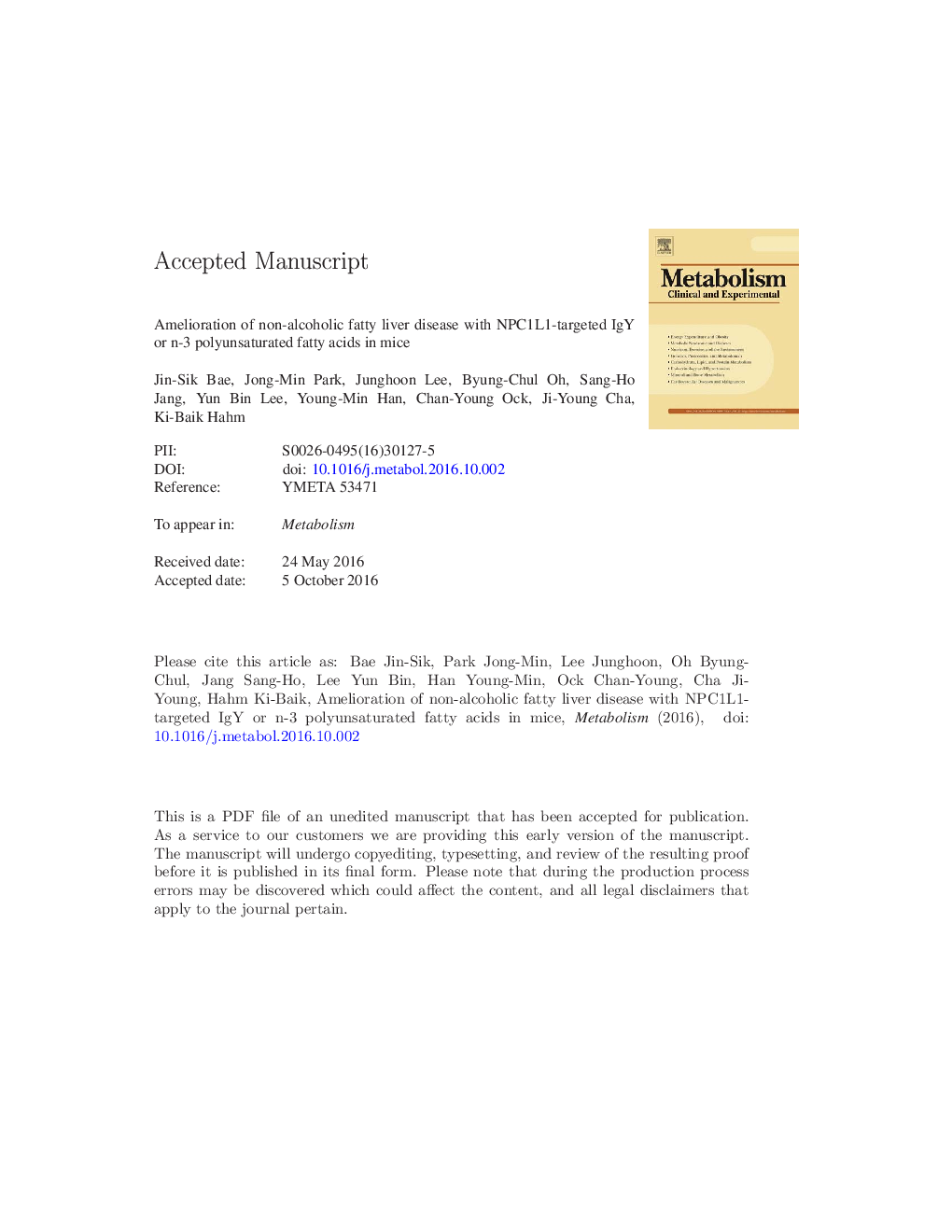| کد مقاله | کد نشریه | سال انتشار | مقاله انگلیسی | نسخه تمام متن |
|---|---|---|---|---|
| 5588537 | 1569043 | 2017 | 33 صفحه PDF | دانلود رایگان |
عنوان انگلیسی مقاله ISI
Amelioration of non-alcoholic fatty liver disease with NPC1L1-targeted IgY or n-3 polyunsaturated fatty acids in mice
دانلود مقاله + سفارش ترجمه
دانلود مقاله ISI انگلیسی
رایگان برای ایرانیان
موضوعات مرتبط
علوم زیستی و بیوفناوری
بیوشیمی، ژنتیک و زیست شناسی مولکولی
علوم غدد
پیش نمایش صفحه اول مقاله

چکیده انگلیسی
Patients with non-alcoholic fatty liver disease (NAFLD) have an increased risk for progression to hepatocellular carcinoma in addition to comorbidities such as cardiovascular and serious metabolic diseases; however, the current therapeutic options are limited. Based on our previous report that omega-3 polyunsaturated fatty acids (n-3 PUFAs) can significantly ameliorate high fat diet (HFD)-induced NAFLD, we explored the therapeutic efficacy of n-3 PUFAs and N-IgY, which is a chicken egg yolk-derived IgY specific for the Niemann-Pick C1-Like 1 (NPC1L1) cholesterol transporter, on NAFLD in mice. We generated N-IgY and confirmed its efficient cholesterol transport-blocking activity in HepG2 and Caco-2 cells, which was comparable to the effect of ezetimibe (EZM). C57BL/6 wild type and fat-1 transgenic mice, capable of producing n-3 PUFAs, were fed a high fat diet (HFD) alone or supplemented with N-IgY. Endogenously synthesized n-3 PUFAs combined with N-IgY led to significant decreases in hepatic steatosis, fibrosis, and inflammation (p < 0.01). The combination of N-IgY and n-3 PUFAs resulted in significant upregulation of genes involved in cholesterol uptake (LDLR), reverse cholesterol transport (ABCG5/ABCG8), and bile acid metabolism (CYP7A1). Moreover, fat-1 transgenic mice treated with N-IgY showed significant downregulation of genes involved in cholesterol-induced hepatic stellate cell activation (Tgfb1, Tlr4, Col1a1, Col1a2, and Timp2). Collectively, these data suggest that n-3 PUFAs and N-IgY, alone or in combination, represent a promising treatment strategy to prevent HFD-induced fatty liver through the activation cholesterol catabolism to bile acids and by decreasing cholesterol-induced fibrosis.
ناشر
Database: Elsevier - ScienceDirect (ساینس دایرکت)
Journal: Metabolism - Volume 66, January 2017, Pages 32-44
Journal: Metabolism - Volume 66, January 2017, Pages 32-44
نویسندگان
Jin-Sik Bae, Jong-Min Park, Junghoon Lee, Byung-Chul Oh, Sang-Ho Jang, Yun Bin Lee, Young-Min Han, Chan-Young Ock, Ji-Young Cha, Ki-Baik Hahm,